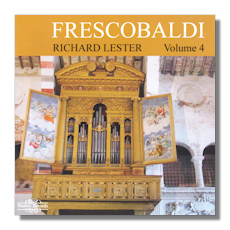
The Internet's Premier Classical Music Source
Related Links
- Frescobaldi Reviews
- Latest Reviews
- More Reviews
-
By Composer
-
Collections
DVD & Blu-ray
Books
Concert Reviews
Articles/Interviews
Software
Audio
Search Amazon
Recommended Links
Site News
 CD Review
CD Review
Girolamo Frescobaldi

Keyboard Sonatas, Volume 4
- Toccata Sesta (1615)
- Toccata terza (1615)
- Toccata per organo
- Toccata Quinta
- Toccata per le Levatione
- Toccata Ottava di durezze e ligature
- Fantasia sesta sopra doi soggietti
- Toccata Quarta
- Canzona seconda
- Toccata Cromaticha per le levatione
- Fantasia Nona
- Canzona Nona alla Francese detta La Querina
- Partite 6 sopra l'Aria di Follia
- Canzon terza
- Canzona sesta, from In partitura, il promo libro delle canzoni (1628)
Richard Lester, organ & harpsichord
Nimbus NI5874
Apart from Lester's steady, studied and delightfully precise technical prowess, one of the defining characteristics of his successful series of CDs exploring the keyboard works of Girolamo Frescobaldi (1583-1643) is that each performance reflects a vibrant historical reality. Lester sets each of Frescobaldi's works in its context from the heart of the seventeenth century. These CDs are not mere recitals of a random selection of music. In order specifically to respect and reflect the reality of Frescobaldi's writing, they turn to the musical milieu of his time. Attention is paid to the instruments, of course; here two harpsichord pieces and fourteen glorious organ ones. And to getting the best from the manuscripts of the scores; this at times requires parallel digging into contemporary treatises and accounts of (performance) practice. But Lester also travels to locations rich in associations with Frescobaldi. He researches the conception, execution and reception of this neglected composer's work; his performances are set in the wider context of Frescobaldi's life, which was an interesting one. Not that these are "concept albums" from Nimbus. The music is very much first and last. But they're being researched and produced in ways that make Frescobaldi come alive. Listen to the Canzon terza [tr.16] and you'll hear resonances of the prevailing English Jacobean and Caroline keyboard idiom as well as those of other mainland European styles.
Classical Net has reviewed very favorably the first, second and third CDs in this series – all featuring Frescobaldi's harpsichord music. This fourth, which opens with a metaphorical fanfare and change of tone in that it turns to the organ, is just as valuable, just as to be sought after and just as worthy of praise. Lester not only presents Frescobaldi's music on its own terms for the glorious body of Renaissance solo instrumental delight that it is. He also, implicitly, quietly and unobtrusively advocates it with his expert playing. His starting point is always what Frescobaldi wrote. There is an unadorned quality to Lester's technique that fosters communication, rather than obscures it. Although Frescobaldi's music is far from plain, to hear depth and reach in the melodies' simple lines and considered tempi is stimulating and satisfying.
Much of the music on this CD is quietly contrapuntal. Lester approaches these toccate and fantasie in such a way that Frescobaldi's own attitude towards counterpoint – stately and measured, rather than fiery or wild – emerges with real clarity. Specifically, the development, the changing logic of the pieces' tempi make them less homogeneous, less monolithic than they otherwise might sound. Although only half a dozen of the works last more than five minutes (and only the Toccata terza [tr.3] is as long as nine minutes), Lester's sensitivity to Frescobaldi's intent makes each one something to treasure in its own right – rather than gloss over as one in a series. Lester's phrasing and pace are conducive to a real understanding of how Frescobaldi wrote his music, how he matured his ideas and how his inspiration was transformed into these vivacious yet emotionally rich works. There's an immediacy to his playing that brings them to life and makes the most of them at every turn. Tone, timbre and flavor are all meticulously delivered. Yet without any hint of over-preparation or lack of spontaneity on the performer's part.
The acoustic of the church of San Nicola in the "commune" of Almenno San Salvatore near Bergamo (Italy) is atmospheric. This recording balances very well the cavernous nature of the space of that church with a forwardness that allows every nuance of the organ (which dates from the end of the sixteenth century) to be heard and appreciated clearly and cleanly. The harpsichord is one of three surviving brass-strung instruments made by Boni a couple of decades later (1620s) than the organ. It's recorded even more closely, allowing every movement and nuance to emerge in the service of a really immediate and energetic pair of performances. Like all good such, we're left wanting more. The booklet that comes with the CD is informative, exact and highly illuminating of Frescobaldi and his world. Well up to Nimbus' usual standards.
If you've yet to sample the glories of Frescobaldi, then this fourth CD in a splendid series will not only convince you that you should. But – given Lester's command of the repertoire – it ought to make you go back and get the first three. As with those, Lester is here offering otherwise unrecorded repertoire as well. Frescobaldi's is wonderful music… dignified, full of life, positive and uncompromising yet with a degree of humanist humility. Try listening to the Toccata Quinta [tr.5] and remaining passive, not swept to your feet by its stupendous power. You won't be able to. This is music-making at its best. This fourth volume is strongly recommended.
Copyright © 2011, Mark Sealey.





















